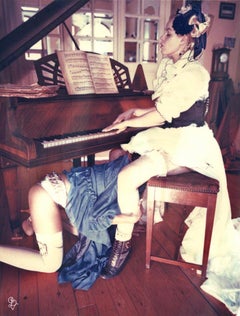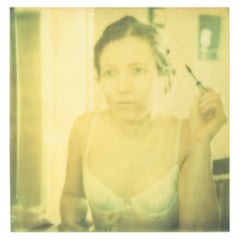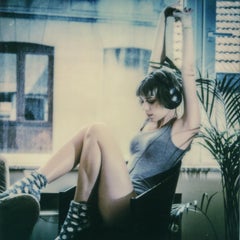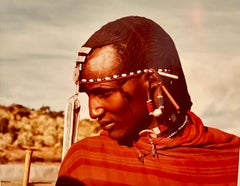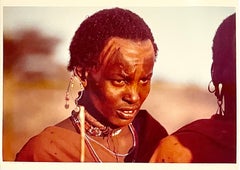Items Similar to Preppers (Heavenly Falls) - Polaroid, Contemporary, 21st Century, Color
Want more images or videos?
Request additional images or videos from the seller
1 of 2
Stefanie SchneiderPreppers (Heavenly Falls) - Polaroid, Contemporary, 21st Century, Color2016
2016
About the Item
Preppers (Heavenly Falls)
2016, 20x24cm, Edition 3/10,
Digital C- Print based on a Polaroid.
Certificate and signature label,
artist inventory number: 19678.03,
unmounted
Stefanie Schneider's Q&A for the Instant Dreams Documentary.
When did you first decide to work with Polaroids and why do Polaroids seem to be so well tuned to our (artistic) senses, perception and minds?
I started using expired Polaroid film in 1996. It has the most beautiful quality and encapsulates my vision perfectly. The colors on one hand, but then the magic moment of witnessing the image appear. Time seems to stand still, and the act of watching the image develop can be shared with the people around you. It captures a moment, which becomes the past so instantly that the decay of time is even more apparent; – it gives the image a certain sentimentality. The Polaroid moment is an original every time.
Why use a medium from the past?
For me, analog has always been there in the present. For the new generation, analog is interesting because it's new to them. I understand that people growing up in a digital age will wonder about its usefulness, but it's theirs to recover if they want to. When I first started working with Polaroid, it wasn't the past. It was a partially forgotten medium, but it existed nonetheless. It is mine by choice. There is no substitute for tangible beauty.
Is it imperfect?
The imperfect perfection in a “wabi-sabi” kind of way.
Wabi-sabi (侘寂) represents a comprehensive Japanese world view or aesthetic centered on the acceptance of transience and imperfection. The aesthetic is sometimes described as one of beauty that is imperfect, impermanent, and incomplete.
'If an object or expression can bring about, within us, a sense of serene melancholy and a spiritual longing, then that object could be said to be wabi-sabi'. 'Wabi-sabi nurtures all that is authentic by acknowledging three simple realities: nothing lasts, nothing is finished, and nothing is perfect.'
Is the Polaroid photograph recognizable or even sometimes cliché?
Absolutely! There's something cliché about the way I'm showing the American Dream. I live it myself, trying to find perfection in an imperfect world. Reaching for the horizon. The dream is broken; the cliché tumbles. There are different ways to involve an audience. You could make movies like Harmony Korine's 'Gummo' a masterpiece in my view, which would estrange a large part of the audience. A certain film education is a prerequisite. Or you can start with clichés, the audience then feels safe, which lures them into the depth of your world without them even knowing it or understanding where exactly they are being led to. Appealing to emotions and the sub-conscious. Normal, Change, New Normal.
You continually revisit the landscape of the American West in your work. What draws you back to this scene?
Southern California represents a dream to me. The contrast of Northern Germany, where I grew up, to the endless sunshine of Los Angeles was what first attracted me. The American West is my dream of choice. Wide, open spaces give perspectives that articulate emotions and desires. Isolation feeds feelings of freedom or sometimes the pondering of your past. The High Desert of 29 Palms has very clear and vivid light, which is vital. Expired Polaroid film produces 'imperfections' that I would argue mirrors the decline of the American dream. These so called 'imperfections' illustrate the reality of that dream turning into a nightmare. The disintegration of Western society.
Are you playing with the temporality of the material and the value of the moment itself?
The value of the moment is paramount, for it is that moment that you're trying to transform. All material is temporary, it's relative, and time is forever.
Why does analog film feel more pure and intuitive?
It's tangible and bright and represents a single moment.
The digital moment may stay in the box (the hard drive / camera / computer etc.) forever, never to be touched, put into a photo album, sent in a letter, or hung on a wall. Printing makes it an accomplishment.
The analog world is more selective, creating images of our collective memory.
The digital worldwide clicking destroys this moment. The generation without memories due to information overload and hard drive failures. Photo albums are a thing of the past.
Why does it feel this way?
That's how the human instinct works.
When I was a child, every picture been taken was a special moment. Analog photographic film as well as Super-8 material were expensive treasures. My family's memories were created by choosing certain moments in time. There was an effort behind the picture. The roll of film might wait months inside the camera before it was all used. From there, the film required developing, which took more time, and finally, when the photos were picked up from the shop, the memories were visited again together as a family. Who knew then, how fleeting these times were. Shared memories was a ritual.
What's your philosophy behind the art of Polaroid pictures?
The 'obsolete' is anything but obsolete. Things are not always as they appear, and there are hidden messages. Our memories and our dreams are under-valued. It is there that real learning and understanding begins by opening yourself to different perspectives.
What inspired you to use stop motion cinematography?
My work has always resembled movie stills. I remember the first time I brought a box of Polaroids and slid them onto Susanne Vielmetter's desk (my first gallery). Instantly, it became apparent that there was a story to tell. The stories grew. It was undeniable to me, that the emerging story was where I was destined to go. I've made four short films before my latest feature film, "The Girl behind the White Picket Fence". This film is 60 minutes long with over 4000 edited Polaroids. It's important to remember that our sub-conscious fills in the blanks, the parts missing from the story allow a deeper and more personal experience for the viewer. That is, if you surrender yourself and trust me as the director to lead you somewhere you might not have been before.
Why do you think it is important to own art?
'We have art in order not to die of the truth' Nietzsche
Interview published in Stefanie's Schneider Instantdreams monograph.
- Creator:Stefanie Schneider (1968, German)
- Creation Year:2016
- Dimensions:Height: 7.88 in (20 cm)Width: 9.45 in (24 cm)Depth: 0.04 in (1 mm)
- Medium:
- Movement & Style:
- Period:
- Condition:new.
- Gallery Location:Morongo Valley, CA
- Reference Number:1stDibs: LU65235351062
Stefanie Schneider
Stefanie Schneider received her MFA in Communication Design at the Folkwang Schule Essen, Germany. Her work has been shown at the Museum for Photography, Braunschweig, Museum für Kommunikation, Berlin, the Institut für Neue Medien, Frankfurt, the Nassauischer Kunstverein, Wiesbaden, Kunstverein Bielefeld, Museum für Moderne Kunst Passau, Les Rencontres d'Arles, Foto -Triennale Esslingen., Bombay Beach Biennale 2018, 2019.
About the Seller
4.9
Platinum Seller
Premium sellers with a 4.7+ rating and 24-hour response times
Established in 1996
1stDibs seller since 2017
1,023 sales on 1stDibs
Typical response time: 3 hours
- ShippingRetrieving quote...Shipping from: morongo valley, CA
- Return Policy
Authenticity Guarantee
In the unlikely event there’s an issue with an item’s authenticity, contact us within 1 year for a full refund. DetailsMoney-Back Guarantee
If your item is not as described, is damaged in transit, or does not arrive, contact us within 7 days for a full refund. Details24-Hour Cancellation
You have a 24-hour grace period in which to reconsider your purchase, with no questions asked.Vetted Professional Sellers
Our world-class sellers must adhere to strict standards for service and quality, maintaining the integrity of our listings.Price-Match Guarantee
If you find that a seller listed the same item for a lower price elsewhere, we’ll match it.Trusted Global Delivery
Our best-in-class carrier network provides specialized shipping options worldwide, including custom delivery.More From This Seller
View AllA Poem dictated by the Corset #31 [From the series Mademoiselle Jean]
By Carmen de Vos
Located in Morongo Valley, CA
31 A Poem dictated by the Corset, 2007/2018
[From the series Mademoiselle Jean]
Digital color print based on original Polaroid on pearl photo paper, not mounted
Hand signed & numbe...
Category
Early 2000s Contemporary Color Photography
Materials
Photographic Paper, C Print, Color, Polaroid
Allegro Moderato (Odd Stories)
By Carmen de Vos
Located in Morongo Valley, CA
'Allegro Moderato' by Carmen De Vos
(Odd Stories) - 1/25, 2014
mounted on black mdf, dimensions 15x11,3cm
(the second image shows a sample piece mounted)
hand signed by the artist on...
Category
2010s Contemporary Color Photography
Materials
Photographic Paper, C Print, Color, Polaroid
Mirorred (Memories of Green) Contemporary, Polaroid, Photograph, Portrait
By Stefanie Schneider
Located in Morongo Valley, CA
Mirrored (Memories of Green) - 2003
58x56cm,
Edition of 5 plus 2 Artist Proofs.
Analog C-Print, hand-printed by the artist on Fuji Crystal Archive Paper, based on the original Pol...
Category
Early 2000s Contemporary Color Photography
Materials
Archival Paper, Photographic Paper, C Print, Color, Polaroid
Escapism - Contemporary, Polaroid, Color, Women, 21st Century
By Kirsten Thys van den Audenaerde
Located in Morongo Valley, CA
Escapism - 2020
20x20cm, Edition of 7 plus 2 Artist Proofs,
digital C-Print based on a Polaroid.
Signed on the back and with certificate.
Artist inventory PL2020-922.
Not mounted....
Category
2010s Contemporary Color Photography
Materials
Archival Paper, Photographic Paper, C Print, Color, Polaroid
BAMBI PANG PANG - Contemporary, Figurative, Polaroid, Photograph, 21st Century
By Carmen de Vos
Located in Morongo Valley, CA
'BAMBI PANG PANG' (Birth & Bees) 2014
Edition 1/25, digital print mounted on mdf, dimensions 15 x 11,3 x 0.8cm, matte coating,
hand signed by the artist on the back. (images 4-6 show a sample piece mounted)
Published in her book The Eyes of the Fox
Part of Photo’s des Femmes - Miami Photo...
Category
2010s Contemporary Color Photography
Materials
Photographic Paper, C Print, Color, Polaroid
Of the Afternoon - Contemporary, Polaroid, Photograph, Figurative, Portrait
By Clare Marie Bailey
Located in Morongo Valley, CA
Of the Afternoon (2019) Edition of 10 - 20 x 20 cm
Digital C-Print based on a Polaroid, not mounted. Signed on back and certificate.
Clare Marie Bailey
Works and Lives: UK
Clare ...
Category
2010s Contemporary Color Photography
Materials
Photographic Film, Photographic Paper, C Print, Color, Polaroid
You May Also Like
Rare Vintage Color C Print Photograph African Maasai Warrior Chromogenic Photo
By Carol Beckwith
Located in Surfside, FL
Carol Beckwith, (American, b. 1945),
Maasai Portrait
Chromogenic print on paper, from Beckwith's book "Maasai" (1980),
Hand signed in pencil, dated and titled with name of sitter in margins,
19" x 16" Sheet.
Carol Beckwith (1945-) is an American photographer, author, and artist known for her photojournalism documenting the indigenous tribal cultures of Africa, most notably in partnership with the Australian photographer Angela Fisher. Between them, Beckwith and Fisher have published 14 books, and have had their photos appear in National Geographic, Natural History, African Arts, The Observer Magazine, Time, Life, Vogue, Marie Claire and Elle.
They continue to exhibit and lecture at galleries and museums worldwide, including The American Museum of Natural History and The Explorers Club in New York City, The Smithsonian Institution in Washington, DC, and the Royal Geographical Society in London. They have also collaborated on four films about African traditions. Together they have received numerous accolades, including the United Nations Award for Excellence, the Royal Geographical Society's Cherry Kearton Medal, two Anisfield-Wolf Book Awards, The Explorers Club Lowell Thomas Award, and the WINGS WorldQuest Lifetime Achievement Award.
Carol Beckwith was born in Boston, Massachusetts, where she went on to attend both the School of the Museum of Fine Arts, Boston and Goucher College in Maryland. After obtaining her degree in Painting and Photography she won a traveling fellowship from the Boston Museum, which let her travel to other countries for the first time.
She spent seven months in Japan, living in a Zen temple and studying calligraphy painting. She continued to travel through Southeast Asia and New Guinea, where she witnessed a "sing-sing", a gathering of 90,000 Highland warriors, in Mount Hagen, and paddled up Chambri Lakes in a canoe, an experience she called "one of the most wonderful, and in a way formative, experiences in my life." Her first trip to Africa was in 1973, when she was invited to spend Christmas with a friend in Kenya. Beckwith bought a 45-day roundtrip ticket and ended up staying eight months. There she encountered the Maasai people who invited her to witness a female circumcision ceremony. Astonished by the ritual, she then determined to spend more time with the Maasai.
Beckwith studied photography in college but had initially intended to become a painter. It was during her travels through New Guinea that she realized the advantages of photography, saying that "there was such a vast amount of exciting material that I began to photograph instead, approaching photography with the eye of a painter in terms of light, color, composition. I wanted the images to be multi layered experiences in a way that a painting is. . . [Photography] seemed to be a more suitable medium for the pace of travel."
Beckwith's first major collaboration was with Tepilit Ole Saitoti, an anthropologist and former Maasai warrior...
Category
1970s Contemporary Color Photography
Materials
Photographic Paper, C Print
Rare Vintage Color C Print Photograph African Maasai Warrior Chromogenic Photo
By Carol Beckwith
Located in Surfside, FL
Carol Beckwith, (American, b. 1945),
Maasai Portrait
Chromogenic print on paper, from Beckwith's book "Maasai" (1980),
Hand signed in pencil, dated and titled with name of sitter in margins,
19" x 16" Sheet.
Carol Beckwith (1945-) is an American photographer, author, and artist known for her photojournalism documenting the indigenous tribal cultures of Africa, most notably in partnership with the Australian photographer Angela Fisher. Between them, Beckwith and Fisher have published 14 books, and have had their photos appear in National Geographic, Natural History, African Arts, The Observer Magazine, Time, Life, Vogue, Marie Claire and Elle.
They continue to exhibit and lecture at galleries and museums worldwide, including The American Museum of Natural History and The Explorers Club in New York City, The Smithsonian Institution in Washington, DC, and the Royal Geographical Society in London. They have also collaborated on four films about African traditions. Together they have received numerous accolades, including the United Nations Award for Excellence, the Royal Geographical Society's Cherry Kearton Medal, two Anisfield-Wolf Book Awards, The Explorers Club Lowell Thomas Award, and the WINGS WorldQuest Lifetime Achievement Award.
Carol Beckwith was born in Boston, Massachusetts, where she went on to attend both the School of the Museum of Fine Arts, Boston and Goucher College in Maryland. After obtaining her degree in Painting and Photography she won a traveling fellowship from the Boston Museum, which let her travel to other countries for the first time.
She spent seven months in Japan, living in a Zen temple and studying calligraphy painting. She continued to travel through Southeast Asia and New Guinea, where she witnessed a "sing-sing", a gathering of 90,000 Highland warriors, in Mount Hagen, and paddled up Chambri Lakes in a canoe, an experience she called "one of the most wonderful, and in a way formative, experiences in my life." Her first trip to Africa was in 1973, when she was invited to spend Christmas with a friend in Kenya. Beckwith bought a 45-day roundtrip ticket and ended up staying eight months. There she encountered the Maasai people who invited her to witness a female circumcision ceremony. Astonished by the ritual, she then determined to spend more time with the Maasai.
Beckwith studied photography in college but had initially intended to become a painter. It was during her travels through New Guinea that she realized the advantages of photography, saying that "there was such a vast amount of exciting material that I began to photograph instead, approaching photography with the eye of a painter in terms of light, color, composition. I wanted the images to be multi layered experiences in a way that a painting is. . . [Photography] seemed to be a more suitable medium for the pace of travel."
Beckwith's first major collaboration was with Tepilit Ole Saitoti, an anthropologist and former Maasai warrior...
Category
1970s Contemporary Color Photography
Materials
Photographic Paper, C Print
Tia - Tim Flach, Contemporary British Art, Animal Photography, Dogs, Chinese
By Tim Flach
Located in Brighton, GB
Please bear in mind that all prints are produced to order. Lead times between 15-20 days.
Edition 2/10
All items are shipped as a print only and come unframed.
Tim Flach is a grad...
Category
Early 2000s Contemporary Color Photography
Materials
Photographic Paper, C Print, Color
Topiary - Tim Flach, Animal Photography, Dogs, Contemporary British Art, Gardens
By Tim Flach
Located in Brighton, GB
Please bear in mind that all prints are produced to order. Lead times between 15-20 days.
Edition 1/10
All items are shipped as a print only and come unframed.
Tim Flach is a grad...
Category
Early 2000s Contemporary Color Photography
Materials
C Print, Photographic Paper, Color
Equus on Blue by Tim Flach (Contemporary British Art, Equine Photography)
By Tim Flach
Located in Brighton, GB
Please bear in mind that all prints are produced to order. Lead times between 15-20 days.
Edition of 9/75
All items are shipped as a print only and come unframed.
Tim Flach is a g...
Category
Early 2000s Contemporary Portrait Photography
Materials
C Print, Paper, Photographic Paper, Color
Untitled #07, Cascais, 2002 - Karine Laval, Swimming Pools, Seascapes, Children
By Karine Laval
Located in Brighton, GB
All prints are produced to order. Lead times between 5-10 days.
Due to currency fluctuations prices may change.
Please contact the gallery for more information about this print.
...
Category
21st Century and Contemporary Contemporary Color Photography
Materials
Photographic Paper, C Print, Color
![A Poem dictated by the Corset #31 [From the series Mademoiselle Jean]](https://a.1stdibscdn.com/carmen-de-vos-photography-a-poem-dictated-by-the-corset-31-from-the-series-mademoiselle-jean-for-sale/a_6523/a_60485421587139132034/carmendevos_07_MlleJean_31_01_master.jpg)
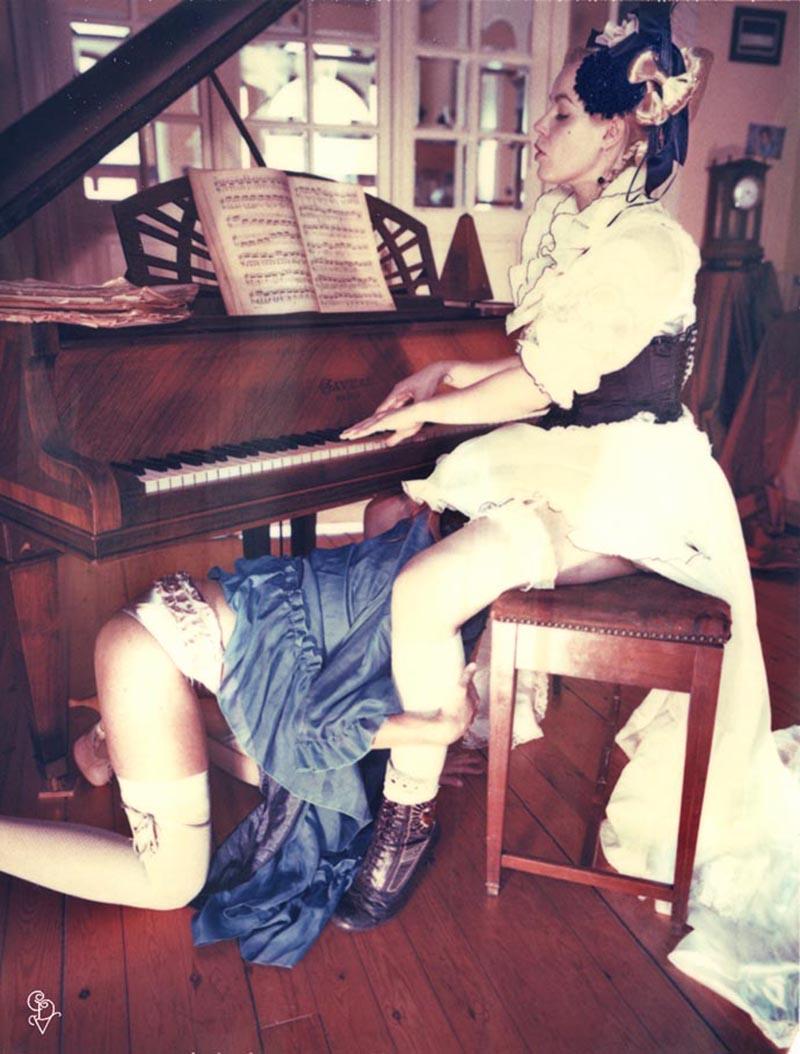
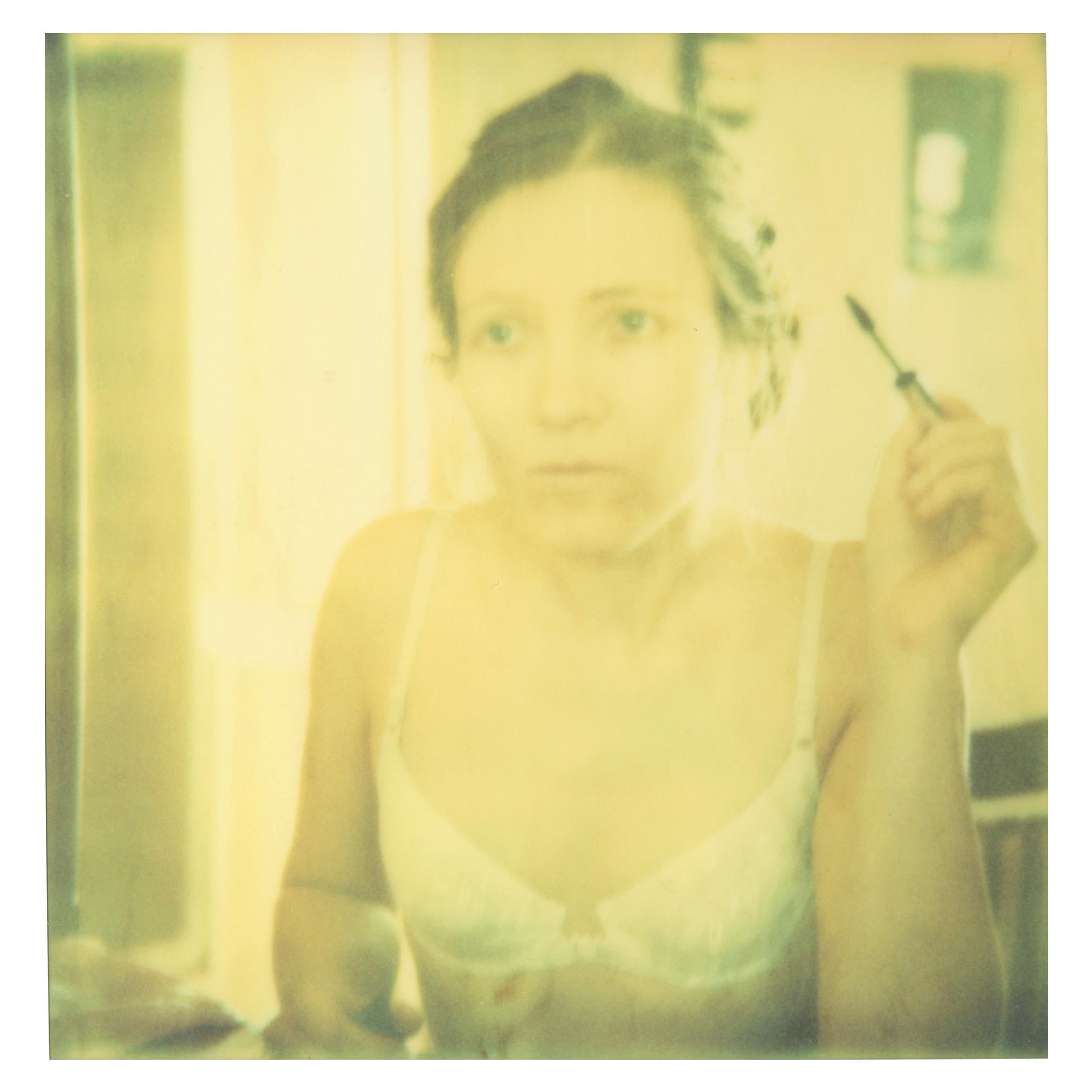
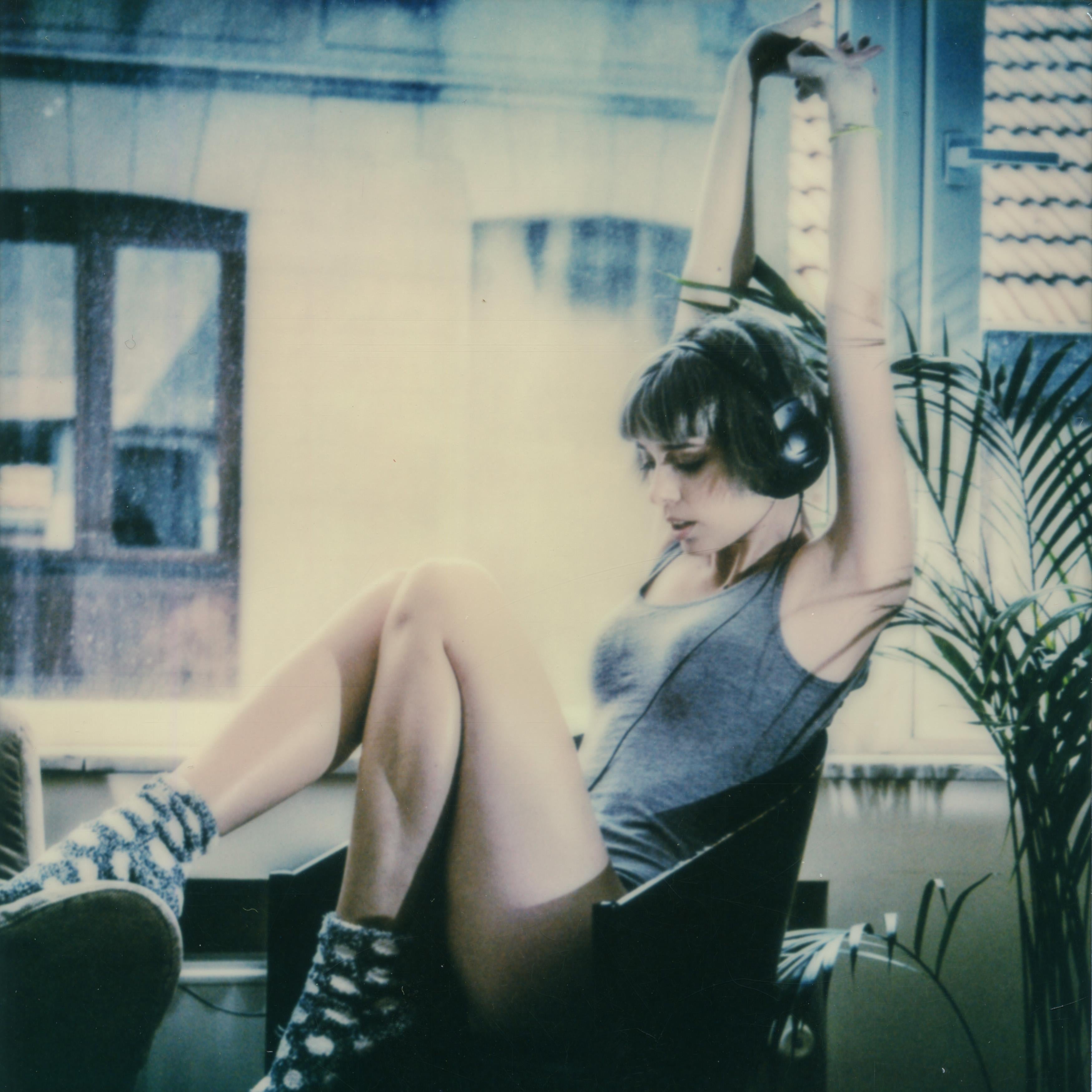
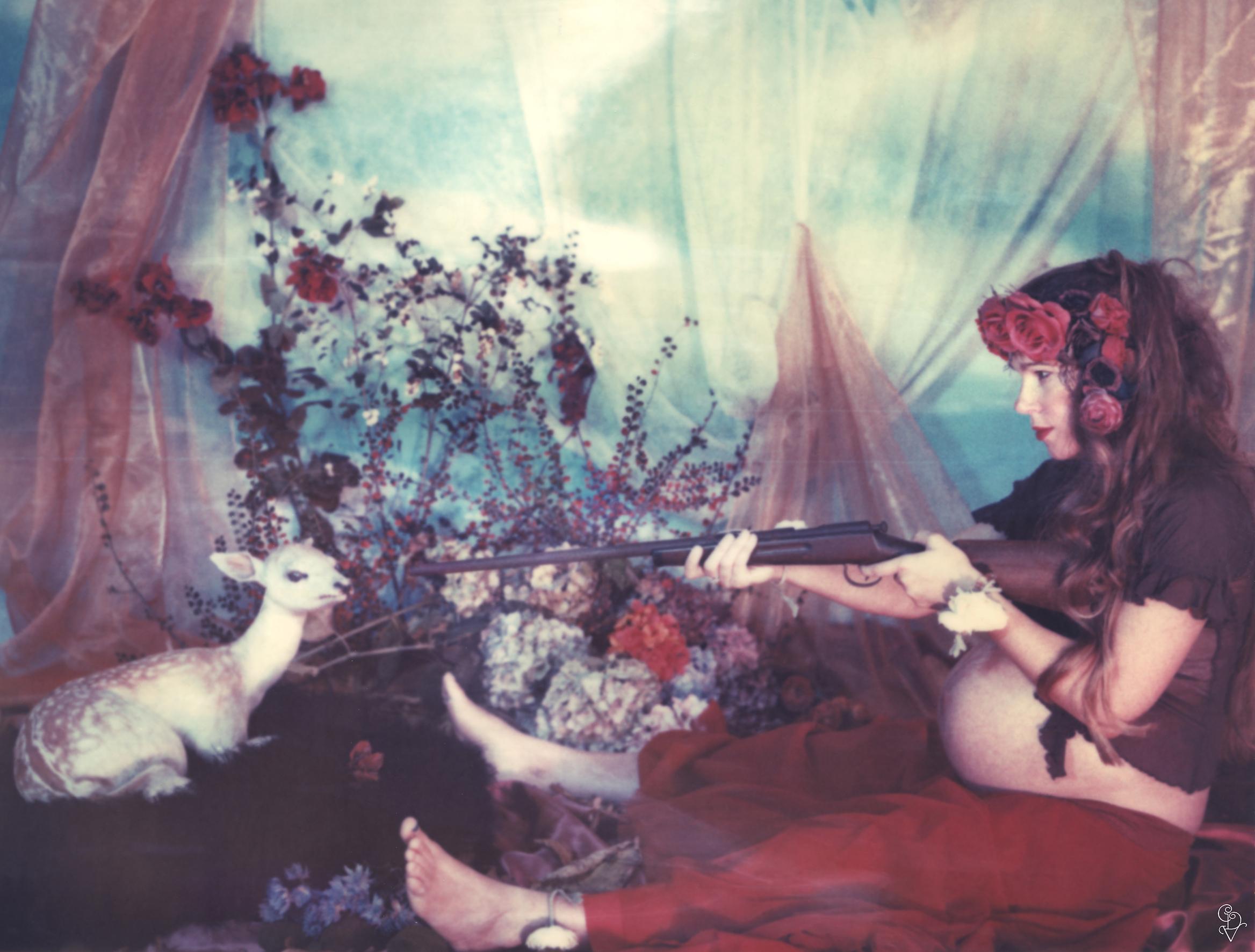
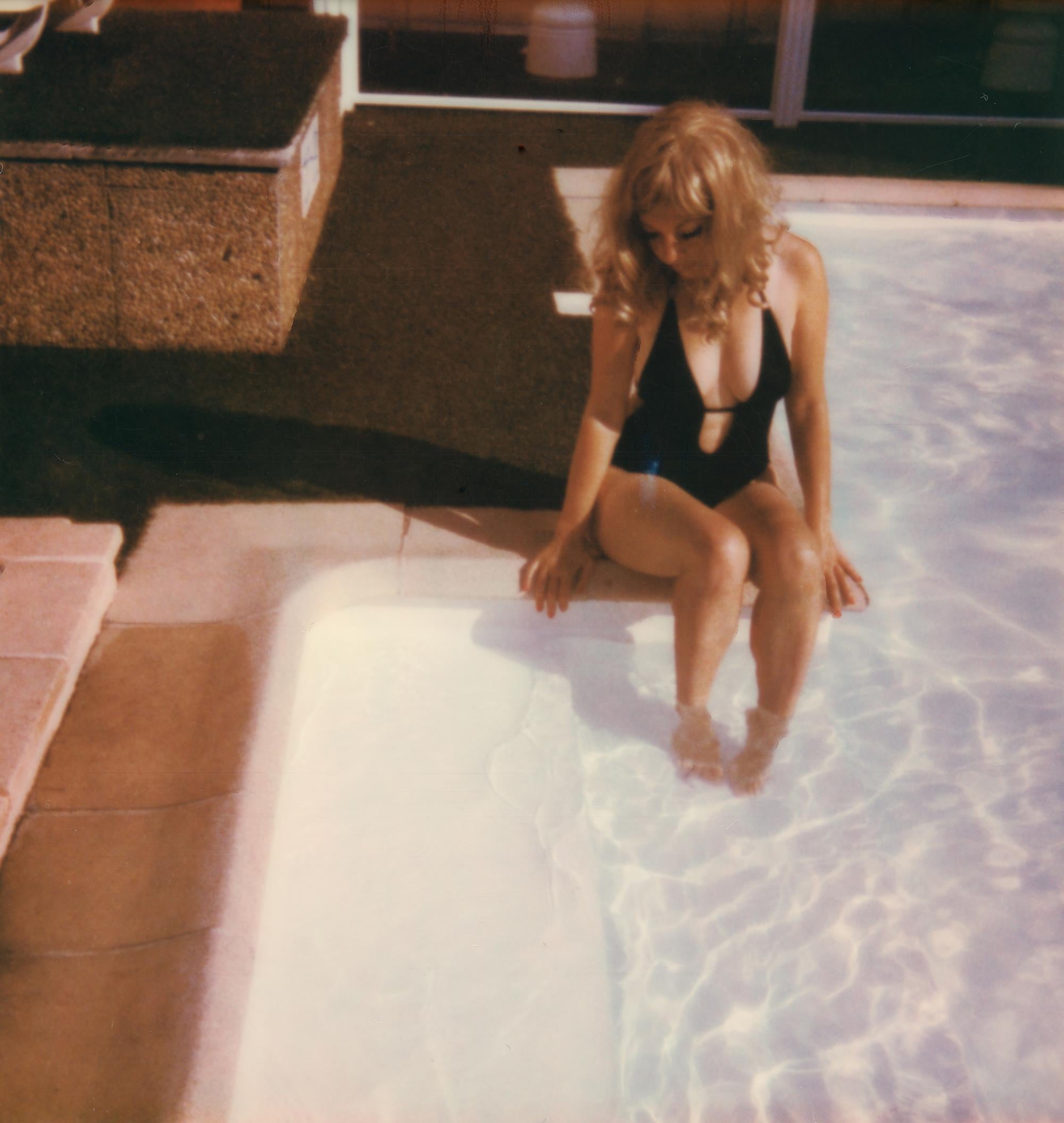
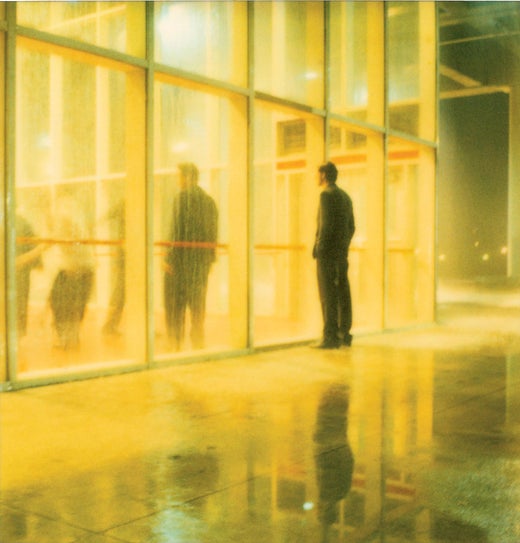
![A Poem dictated by the Corset #31 [From the series Mademoiselle Jean]](https://a.1stdibscdn.com/carmen-de-vos-photography-a-poem-dictated-by-the-corset-31-from-the-series-mademoiselle-jean-for-sale/a_6523/a_60485421587139132034/carmendevos_07_MlleJean_31_01_master.jpg?width=240)
